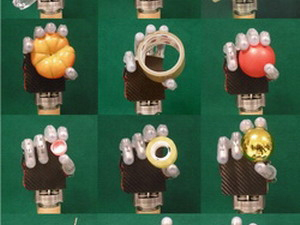For the first time, a robot hand feels
A group of international scientists led by Lund University in Sweden has successfully developed a 'smart hand' that not only recreates the precise movements of the real hand but also helps users to regain be feeling.
Researched on a variety of technologies in the field of cognitive neuroscience (cognitive neuroscience), this hand consists of 4 motors and 40 sensors used to create movement and sensation.

'Smart hands' not only reproduce the precise movements of real hands but also help users get back
This is the first device of its kind that can transmit signals to the brain, allowing users to see the sensations in their fingers and hands.
With the use of impulses transmitted by the brain to truncated places through neurons, scientists can use these signals and transfer them to a mechanical device.
That makes the smart hand 'unique' because it takes advantage of the virtual hand syndrome (the feeling of the handicapped that the lost body part remains and thereby creates impulses) is available.
By connecting the sensors in the robotic hand to the nerve endings in the amputated hand sockets, the victims can feel and manipulate the smart hand.
This 10-year study is worth 1.8 million euros in collaboration with scientists from Italy, Denmark, Israel, Ireland and Iceland.
- The robot hand solves the Rubik's cube in just about 4 minutes
- Italy has successfully built a new generation of handheld robot for the disabled
- The external robot arm costs only 65 USD
- The coldest is not the lowest temperature, but this time!
- The robotic hand accurately identifies more than 100 materials
- Ziro: The system allows you to design robots and control them through hand movements
- Hand surgery robot remote
- Spotmini robot launches new version: compact and more doggy
- 7 robots are born only to do extremely simple tasks
- Bebionic3 robot hand - Cyborg's future is not far away
- 5 most horror robots you've ever seen
- Russia for the first time launched a robot carrying a human figure on ISS
 Daily use inventions come from universities
Daily use inventions come from universities Special weight loss device helps prevent appetite
Special weight loss device helps prevent appetite 8 inventors were killed by their own inventions
8 inventors were killed by their own inventions Iran invented a motor car powered by water
Iran invented a motor car powered by water 'Unveiling' the painful truth behind the experiment that created the world's first X-rays
'Unveiling' the painful truth behind the experiment that created the world's first X-rays  Waterproof electronic glove design
Waterproof electronic glove design  Korea develops robotic hand as flexible as human hand
Korea develops robotic hand as flexible as human hand  The robot hand can already look like this, the future of Terminator is one step closer
The robot hand can already look like this, the future of Terminator is one step closer  The man had to have his arm amputated by a shrimp to save his life
The man had to have his arm amputated by a shrimp to save his life  The girl was hand grafted from black young man, 2 years after the miracle happened
The girl was hand grafted from black young man, 2 years after the miracle happened 